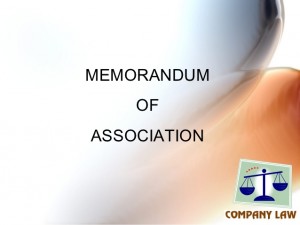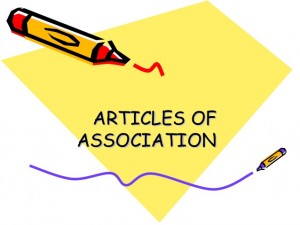In this blog post, Ashok K. K. Vasudevan, the Managing Director at Festo Global Production Centre, India and a student pursuing a Diploma in Entrepreneurship Administration and Business Laws from NUJS, Kolkata, describes the people authorised to take decisions in a company.
Registrar of Companies (ROC) (1)
Before we embark on determining ways of finding out who is authorized to make particular decisions in a company, it is mandatory to understand what the Registrar of Company means and does. Under Section 609 of the Companies  Act which covers the various States and Union Territories, the appointment of the Registrar of Companies (ROC) is accomplished, which is vested with the primary duty of registering companies and Limited Liability Partnerships (LLPs) that are floated in the respective States and Union Territories. The ROC ensures that such companies floated, comply with the statutory requirements under the Act. The Registrar of Companies functions as a registry of records relating to the companies registered with them. These records are available for inspection by the public on payment of the prescribed fee. The Registrar of Companies falls under the administrative ambit of the Central Government. The Central Government exercises administrative control over these ROCs through the respective Regional Directors.
Act which covers the various States and Union Territories, the appointment of the Registrar of Companies (ROC) is accomplished, which is vested with the primary duty of registering companies and Limited Liability Partnerships (LLPs) that are floated in the respective States and Union Territories. The ROC ensures that such companies floated, comply with the statutory requirements under the Act. The Registrar of Companies functions as a registry of records relating to the companies registered with them. These records are available for inspection by the public on payment of the prescribed fee. The Registrar of Companies falls under the administrative ambit of the Central Government. The Central Government exercises administrative control over these ROCs through the respective Regional Directors.
Thus, the Registrar of Companies (ROC) will stand to be a good source for information related to listed/unlisted companies registered with ROC.
Memorandum of Association (MOA) and Articles of Association (AOA) (2)
All companies have their Memorandum of Association (MOA) and Articles of Association (AOA) which are registered with the ROC at the time of registration of companies.
Memorandum of Association (MOA)
The Memorandum of Association (MOA) is the ultimate public document which contains all information which is required for the company to declare at the time of incorporation. To emphasize the importance of MOA, it can also be said that a company cannot be incorporated without its memorandum and is a requirement for the company to register its MOA with the ROC at the time of the registration of the company. The MOA contains the objects, powers, and scope of a company, beyond which the company is not allowed to work. In other words, the MOA limits the range of the activities of the company.
The Memorandum is also known as the charter of the company, and there are six essential conditions to framing a Memorandum. These are:
- Name Clause: There are limitations as to what the name of the company should be and should conform to the prescribed norms and also should not too closely resemble the name of any other company.
- Situation Clause: The name of the state in which the registered office of the company is located needs to be specified.
- Object Clause: The main and auxiliary objects of the company need to be specified in the Memorandum.
- Liability Clause: All details regarding the liabilities of the members of the company need to be included in the Memorandum.
- Capital Clause: The total capital of the company needs to be included in the Memorandum.
- Subscription Clause: Details of the subscribers, their relevant shares and such information related to the subscription need to be included.
Articles of Association (AOA)
The Articles of Association (AOA) is a secondary document which defines the rules and regulations as defined by the company for its administration and day-to-day management. Additionally, the articles contain the rights, responsibilities, powers and duties of members and directors of the company. The AOA also includes the information on the accounts and audits of the company.
Additionally, the articles contain the rights, responsibilities, powers and duties of members and directors of the company. The AOA also includes the information on the accounts and audits of the company.
Every company should have its articles. However, a public company limited by shares can adopt Table A in place of the Articles of Association. This comprises all the necessary information regarding the internal affairs, and the management of the company. It is prepared for the persons inside the company, i.e., members, employees, directors, etc. and the governance of the company is done according to the rules prescribed in it. The companies can frame its articles of association as per their requirements and choices.
Key Differences Between Memorandum of Association (MOA) and Articles of Association (AOA)
The major differences between a Memorandum of Association and Articles of Association can be elaborated as follows:
- The MOA is a document which contains all the conditions that are necessary for the registration of the company. The AOA is a document which contains all the rules and regulations about the administration of the company.
- The MOA is defined in Section 2 (28) while the AOA is defined in Section 2 (2) of the Indian Companies Act of 1956. In the Companies Act 2013, the MOA and AOA are defined in Section 2 (56) and Section 2 (5) respectively.
- The MOA is a subsidiary to the Companies Act, whereas Articles of Association is a subsidiary to both MOA as well as to the Companies Act.

- In the event of any contradiction between the MOA and AOA about any clause, the MOA will prevail over the AOA.
- The MOA contains information about the powers and objects of the company. The AOA contains information about the rules and regulations of the company.
- MOA contains the six clauses, namely (i) Name Clause (ii) Situation Clause (iii) Object Clause (iv) Liability Clause (v) Capital Clause and (vi) Subscription Clause, whereas the AOA is framed as per the discretion of the company.
- MOA is obligatory to be registered with the ROC at the time of registration of the company. The AOA is not required to be filed with the Registrar, but the company can file it on a voluntary basis.
Conclusion
Coming back to the main topic as to how one can find out as to who are authorized to take particular decisions in a company, we can always refer to the Registrar of Companies (ROC) to obtain information of the Memorandum of Association (MOA) and Articles of Association (AOA) of any related company by paying the relevant prescribed fee. These two documents help in the proper management and functioning of the company in its entire period of existence.
Additionally, the Annual General Meeting (AGM) held by a company every year gives insights into any Ordinary Business of the company (Section 102(2)), Special Business of the company (Section 102(b)) and is duly signed by the Board of Directors, who govern the affairs of the company.
[divider]References
- http://www.mca.gov.in/MinistryV2/contact.html (1)
- http://keydifferences.com/difference-between-memorandum-of-association-and-articles-of-association.html(2)
 Serato DJ Crack 2025Serato DJ PRO Crack
Serato DJ Crack 2025Serato DJ PRO Crack











 Allow notifications
Allow notifications



